Architectural Chairs
Design for seating objects, as a part of furniture design, is anemoscope showing changes and new directions in styles and ideologies. Especially chairs in 20th century reflect the important changes caused by advance of technology and manufacturing, and preferences and ardent desire of the times. Many of the famous chair designers, having another business card as architects, were enthusiastic about daring unprecedented experiments to investigate way of expression through the adoptions of state-of-the-art morphology and materials. The following five representative seating pieces deal with Functionalism, Minimalism, Arts and Crafts Movement, Art Deco, Modernism and Postmodernism.
No. 14 Chair (1859)
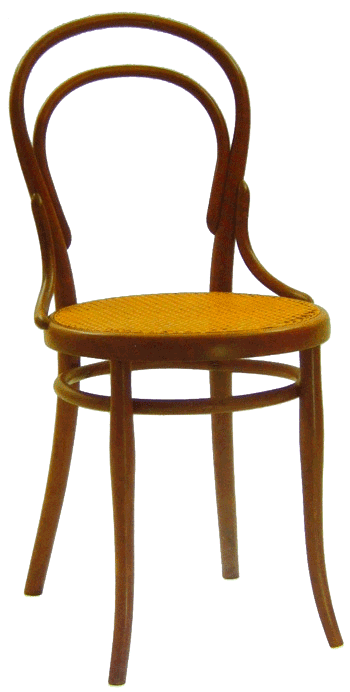
Michael Thonet's No. 14 Chair was based on the techniques which were prevalent among beer barrel and boat makers to bend beechwood strips with less labor. Thin wood pieces were clamped and dried in a tin frame for extreme bending. After making the first layered wooden chair in 1836, Michael acquired the patent about bentwood process. Influenced by the exhibition in London Expo in 1851, the No. 14 chair was devised mainly focused on export. Consisted of four simple parts, the chair enabled compact packing to occupy less space in the cargo boat and easy assembly even at home. The "do-it-yourself" concept has something in common with IKEA’s way but the No. 14 Chair was one of the rare furniture endorsed by Le Corbusier who had sought for perfect items coincident with his notion (see third chair below). The chair with low price backed by mass-production was recognized by modernism designers in the 20th century.
Red & Blue Armchair (1918)
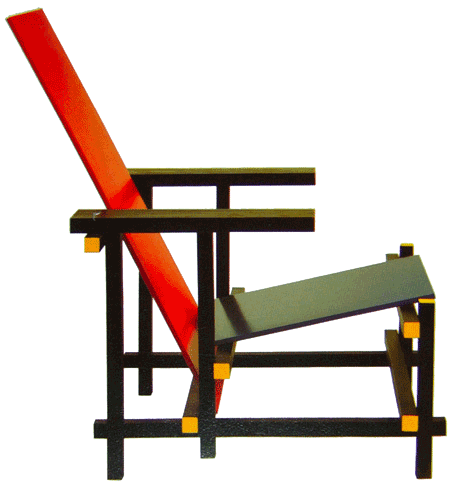
The intensity of visual shock hit by Gerrit Rietveld's Red and Blue Armchair can be referred by a number of books dealing with design history in 20th century. Gerrit, who had a strong background in traditional arts and crafts under his father, was a linchpin of De Stijl, which was the most powerful and aggregate group advocating modernization movement in the era so the armchair was a symbol of modernization. The participation in De Stijl had changed his design drastically so that new elements such as vivid colors, basic geometric shapes, abstract forms were streamed into his design process of the chair. Especially Piet Mondrian's paintings were eloquent of those constituents and Gerrit materialized the inspiration into the chair, as a 3-d object of the abstract art piece.
Fauteuil, Modèle Petit Confort (1928)
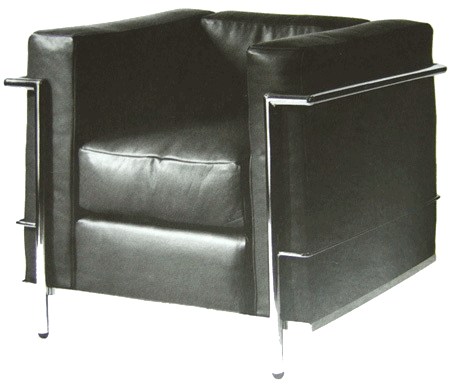
Le Corbusier, who promoted the architecture idology proclaiming "space of continuum flowing through without clogging in," designed a series of furniture by himself to fit it in his structures. The chairs as "machine for seating" became a part of the houses as "machine for dwelling", like sculptures, to help synergetically create the "flowing space." The Fauteuil, Modèle Petit Confort was a "seating equipment" designed to be an element of his architecture to integrate the house into a whole being. The original models had diversity in size cushioned with feathers in and sustained by soared metal legs.
Stacking Stool "L" Leg (1932)
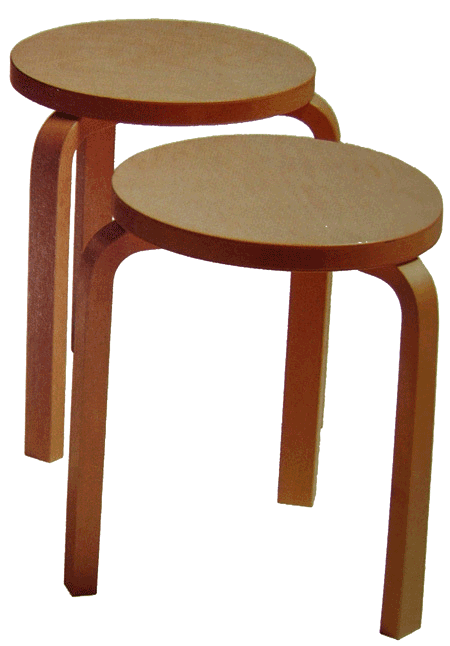
The transcendental design of the Stacking Stool rises above the period and time. The aesthetic consciouness of architecture which Alvar Aalto had originally was totally succeeded to his furniture design. The plywood chair was once recognized as a sculpture for the interior. The intrinsic modernity has inspired many designers and even furniture giants such as IKEA. The natural materials and simple curves reflect his interests in organic forms, humanism and humanitarian aesthetics. The core ideologies - functionalism and modernism - implied in the chair were incarnated as the commercial products from Artek and their splendid results proved that the public had sufficient acceptability to the ideas.
4867 Chair (1965)
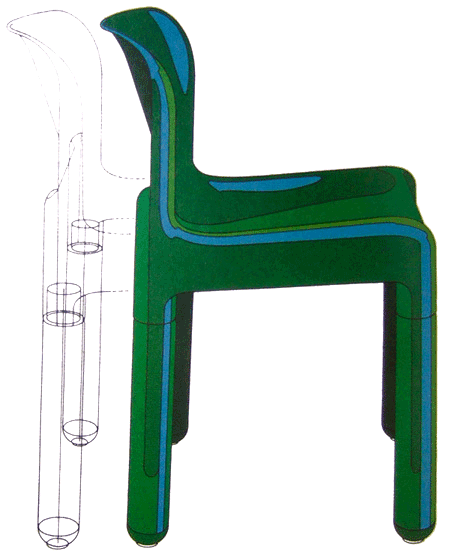
The premature death highlighted the reputation for Cesare Columbo's innovative and creative work. Upon the architectural and art education, he adopted new technology and materials into his design vigorously and the 4867 chair was at the zenith. It was the first plastic chair manufactured by injection molding process so that it had a unified seating and backing part unlike conventional chairs with separated ones. Cesare patented it and created fresh and various forms made of plastic which was the up-to-date material in the period. Now plastic chairs are spread all over the world and they are nothing more than cheap and light seating objects. However all of them have some essence of the 4867 chair which became a sensational precursor.
Design for seating objects, as a part of furniture design, is anemoscope showing changes and new directions in styles and ideologies. Especially chairs in 20th century reflect the important changes caused by advance of technology and manufacturing, and preferences and ardent desire of the times. Many of the famous chair designers, having another business card as architects, were enthusiastic about daring unprecedented experiments to investigate way of expression through the adoptions of state-of-the-art morphology and materials. The following five representative seating pieces deal with Functionalism, Minimalism, Arts and Crafts Movement, Art Deco, Modernism and Postmodernism.
No. 14 Chair (1859)

Michael Thonet's No. 14 Chair was based on the techniques which were prevalent among beer barrel and boat makers to bend beechwood strips with less labor. Thin wood pieces were clamped and dried in a tin frame for extreme bending. After making the first layered wooden chair in 1836, Michael acquired the patent about bentwood process. Influenced by the exhibition in London Expo in 1851, the No. 14 chair was devised mainly focused on export. Consisted of four simple parts, the chair enabled compact packing to occupy less space in the cargo boat and easy assembly even at home. The "do-it-yourself" concept has something in common with IKEA’s way but the No. 14 Chair was one of the rare furniture endorsed by Le Corbusier who had sought for perfect items coincident with his notion (see third chair below). The chair with low price backed by mass-production was recognized by modernism designers in the 20th century.
Red & Blue Armchair (1918)

The intensity of visual shock hit by Gerrit Rietveld's Red and Blue Armchair can be referred by a number of books dealing with design history in 20th century. Gerrit, who had a strong background in traditional arts and crafts under his father, was a linchpin of De Stijl, which was the most powerful and aggregate group advocating modernization movement in the era so the armchair was a symbol of modernization. The participation in De Stijl had changed his design drastically so that new elements such as vivid colors, basic geometric shapes, abstract forms were streamed into his design process of the chair. Especially Piet Mondrian's paintings were eloquent of those constituents and Gerrit materialized the inspiration into the chair, as a 3-d object of the abstract art piece.
Fauteuil, Modèle Petit Confort (1928)

Le Corbusier, who promoted the architecture idology proclaiming "space of continuum flowing through without clogging in," designed a series of furniture by himself to fit it in his structures. The chairs as "machine for seating" became a part of the houses as "machine for dwelling", like sculptures, to help synergetically create the "flowing space." The Fauteuil, Modèle Petit Confort was a "seating equipment" designed to be an element of his architecture to integrate the house into a whole being. The original models had diversity in size cushioned with feathers in and sustained by soared metal legs.
Stacking Stool "L" Leg (1932)

The transcendental design of the Stacking Stool rises above the period and time. The aesthetic consciouness of architecture which Alvar Aalto had originally was totally succeeded to his furniture design. The plywood chair was once recognized as a sculpture for the interior. The intrinsic modernity has inspired many designers and even furniture giants such as IKEA. The natural materials and simple curves reflect his interests in organic forms, humanism and humanitarian aesthetics. The core ideologies - functionalism and modernism - implied in the chair were incarnated as the commercial products from Artek and their splendid results proved that the public had sufficient acceptability to the ideas.
4867 Chair (1965)

The premature death highlighted the reputation for Cesare Columbo's innovative and creative work. Upon the architectural and art education, he adopted new technology and materials into his design vigorously and the 4867 chair was at the zenith. It was the first plastic chair manufactured by injection molding process so that it had a unified seating and backing part unlike conventional chairs with separated ones. Cesare patented it and created fresh and various forms made of plastic which was the up-to-date material in the period. Now plastic chairs are spread all over the world and they are nothing more than cheap and light seating objects. However all of them have some essence of the 4867 chair which became a sensational precursor.